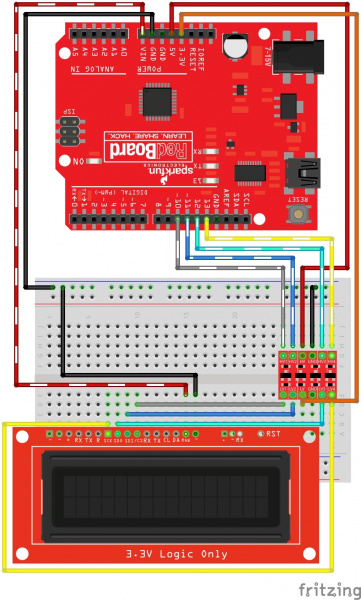AVR-Based Serial Enabled LCDs Hookup Guide
Contributors:
 QCPete
QCPete
SPI: Hardware Hookup & Example Code - Basic
Here's how to wire up your RedBoard to talk SPI to your LCD screen. Remember, convert those logic levels to 3.3Vs! Also note, you could choose a different output pin for the csPin, but in this example we are using D10.
With your hardware now hooked up, the following code is the SPI basic example - it simply writes some characters to the screen over SPI. It has a counter that will increment on each cycle of your main loop. It clears the screen at the top of each loop, so you simply see "Cycles: 1", "Cycles: 2" and so on.
Note: Depending on your processor (such as the SAMD21 on the Qwiic Micro), you may need to add a small delay (i.e.
delay(5)) between the clear command ('-') and sending a string in order for the string to display properly. .
.
.
//Send the clear display command to the display - this forces the cursor to return to the beginning of the display
digitalWrite(csPin, LOW); //Drive the CS pin low to select OpenLCD
SPI.transfer('|'); //Put LCD into setting mode
SPI.transfer('-'); //Send clear display command
delay(10); //<==== add slight delay here
digitalWrite(csPin, HIGH); //Release the CS pin to de-select OpenLCDYou can get the latest example code from the GitHub repo or you can copy and paste the following code into your Arduino IDE:
language:cpp
/*
OpenLCD is an LCD with Serial/I2C/SPI interfaces.
By: Nathan Seidle
SparkFun Electronics
Date: April 19th, 2015
License: This code is public domain but you buy me a beer if you use this and we meet someday (Beerware license).
This is example code that shows how to send data over SPI to the display.
To get this code to work, attached an OpenLCD to an Arduino Uno using the following pins:
CS (OpenLCD) to 10 (Arduino)
SDI to 11
SDO to 12 (optional)
SCK to 13
VIN to 5V
GND to GND
Command cheat sheet:
ASCII / DEC / HEX
'|' / 124 / 0x7C - Put into setting mode
Ctrl+c / 3 / 0x03 - Change width to 20
Ctrl+d / 4 / 0x04 - Change width to 16
Ctrl+e / 5 / 0x05 - Change lines to 4
Ctrl+f / 6 / 0x06 - Change lines to 2
Ctrl+g / 7 / 0x07 - Change lines to 1
Ctrl+h / 8 / 0x08 - Software reset of the system
Ctrl+i / 9 / 0x09 - Enable/disable splash screen
Ctrl+j / 10 / 0x0A - Save currently displayed text as splash
Ctrl+k / 11 / 0x0B - Change baud to 2400bps
Ctrl+l / 12 / 0x0C - Change baud to 4800bps
Ctrl+m / 13 / 0x0D - Change baud to 9600bps
Ctrl+n / 14 / 0x0E - Change baud to 14400bps
Ctrl+o / 15 / 0x0F - Change baud to 19200bps
Ctrl+p / 16 / 0x10 - Change baud to 38400bps
Ctrl+q / 17 / 0x11 - Change baud to 57600bps
Ctrl+r / 18 / 0x12 - Change baud to 115200bps
Ctrl+s / 19 / 0x13 - Change baud to 230400bps
Ctrl+t / 20 / 0x14 - Change baud to 460800bps
Ctrl+u / 21 / 0x15 - Change baud to 921600bps
Ctrl+v / 22 / 0x16 - Change baud to 1000000bps
Ctrl+w / 23 / 0x17 - Change baud to 1200bps
Ctrl+x / 24 / 0x18 - Change the contrast. Follow Ctrl+x with number 0 to 255. 120 is default.
Ctrl+y / 25 / 0x19 - Change the TWI address. Follow Ctrl+x with number 0 to 255. 114 (0x72) is default.
Ctrl+z / 26 / 0x1A - Enable/disable ignore RX pin on startup (ignore emergency reset)
'-' / 45 / 0x2D - Clear display. Move cursor to home position.
/ 128-157 / 0x80-0x9D - Set the primary backlight brightness. 128 = Off, 157 = 100%.
/ 158-187 / 0x9E-0xBB - Set the green backlight brightness. 158 = Off, 187 = 100%.
/ 188-217 / 0xBC-0xD9 - Set the blue backlight brightness. 188 = Off, 217 = 100%.
For example, to change the baud rate to 115200 send 124 followed by 18.
*/
#include <SPI.h>
int csPin = 10; //You can use any output pin but for this example we use 10
int cycles = 0;
void setup()
{
pinMode(csPin, OUTPUT);
digitalWrite(csPin, HIGH); //By default, don't be selecting OpenLCD
SPI.begin(); //Start SPI communication
//SPI.beginTransaction(SPISettings(100000, MSBFIRST, SPI_MODE0));
SPI.setClockDivider(SPI_CLOCK_DIV128); //Slow down the master a bit
}
void loop()
{
cycles++; //Counting cycles! Yay!
//Send the clear display command to the display - this forces the cursor to return to the beginning of the display
digitalWrite(csPin, LOW); //Drive the CS pin low to select OpenLCD
SPI.transfer('|'); //Put LCD into setting mode
SPI.transfer('-'); //Send clear display command
digitalWrite(csPin, HIGH); //Release the CS pin to de-select OpenLCD
char tempString[50]; //Needs to be large enough to hold the entire string with up to 5 digits
sprintf(tempString, "Cycles: %d", cycles);
spiSendString(tempString);
//25ms works well
//15ms slight flickering
//5ms causes flickering
delay(250);
}
//Sends a string over SPI
void spiSendString(char* data)
{
digitalWrite(csPin, LOW); //Drive the CS pin low to select OpenLCD
for(byte x = 0 ; data[x] != '\0' ; x++) //Send chars until we hit the end of the string
SPI.transfer(data[x]);
digitalWrite(csPin, HIGH); //Release the CS pin to de-select OpenLCD
}
